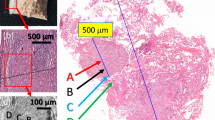Abstract
Purpose
The aim of this article is to correlate the radiological features of pleuro-pulmonary damage caused by inhalation of pumice (an extrusive volcanic rock classified as a non-fibrous, amorphous, complex silicate) with exposure conditions.
Materials and methods
36 subjects employed in the pumice quarries were evaluated for annual follow-up in a preventive medical surveillance program including spirometry, chest CT lasting from 1999 to 2014. They were only male subjects, mean age 56.92 ± 16.45 years. Subjects had worked in the quarries for an average of 25.03 ± 9.39 years. Domestic or occupational exposure to asbestos or other mineral dusts other than pumice was excluded. Subjects were also classified as smokers, former smokers and nonsmokers.
Results
Among the 36 workers examined, we identified four CT patterns which resulted to be dependent on exposure duration and intensity, FVC, FEV1 and FEF25–75, but not on cigarette smoking. The most common symptoms reported by clinical examination were dyspnoea, cough and asthenia. In no case it was proven an evolution of CT findings during follow-up for 10 years.
Conclusions
Liparitosis, caused by pumice inhalation, can be considered a representative example of pneumoconiosis derived by amorphous silica compounds, which are extremely widespread for industrial manufacturing as well as for applicative uses, such as nano-materials. Moreover, being pumice free of quartz contamination, it can represent a disease model for exposure to pure non-fibrous silicates.






Similar content being viewed by others
References
Pumex S.p.A (1985) La pomice di Lipari 3rd edn. Carminati Stampatore, Bergamo
Castronovo E (1953) Aspetto radiologico della pneumoconiosi da pomice (liparosi) e sua interpretazione patogenetica [The radiological aspect of liparosis and its pathogenic interpretation]. Riv delle Infez e delle Mal Prof 278–289
Falaschi F, Battolla L, Paolicchi A et al (1995) High-resolution computed tomography compared with the thoracic radiogram and respiratory function tests in assessing workers exposed to silica. Radiol Med 89:424–429
Olivetti L, Grazioli L, Milanesio L, Provezza A, Chiodera P, Tassi G, Bergonzini R (1993) Anatomo-radiologic definition of minimal interstitial silicosis and diagnostic contribution of high-resolution computerized tomography. Radiol Med 85:600–605
Mossman BT, Borm PJ, Castranova V, Costa DL, Donaldson K, Kleeberger SR (2007) Mechanisms of action of inhaled fibers, particles and nanoparticles in lung and cardiovascular diseases. Part Fibre Toxicol 4:4
Balbus JM, Maynard AD, Colvin VL et al (2007) Meeting report: hazard assessment for nanoparticles—report from an interdisciplinary workshop. Environ Health Perspect 115:1654–1659
Mazziotti S, Gaeta M, Costa C et al (2004) Computed tomography features of liparitosis: a pneumoconiosis due to amorphous silica. Eur Respir J 23:208–213
American Thoracic Society/European Thoracic Society (ATS/ERS) (2005) Standardisation of lung function testing: standardization of spirometry. Eur Respir J 26:319–338
American Conference of Governmental Industrial Hygienists (ACGIH), Cincinnati, OH, USA (2006) Threshold Limit Values and Biological Exposure Indices
Barik TK, Sahu B, Swain V (2008) Nanosilica—from medicine to pest control. Parasitol Res 103:253–258
Merget R, Bauer T, Küpper HU et al (2002) Health hazards due to the inhalation of amorphous silica. Arch Toxicol 75:625–634
Abrams HK (1990) Historical perspectives in occupational medicine. Diatomaceous earth silicosis. Am J Ind Med 18:591–597
Gibbs AR, Pooley FD (1994) Fuller’s earth (montmorillonite) pneumoconiosis. Occup Environ Med 51:644–646
Mazziotti S, Costa C, Ascenti G, Lamberto S, Scribano E (2002) Unusual pleural involvement after exposure to amorphous silicates (Liparitosis): report of two cases. Eur Radiol 12:1058–1060
Wagner JC, Wusteman FS, Edwards JH, Hill RJ (1975) The composition of massive lesions in coal miners. Thorax 30:382–388
Choudat D, Frisch C, Barrat G, el Kholti A, Conso F (1990) Occupational exposure to amorphous silica dust and pulmonary function. Br J Ind Med 47:763–766
Wilson RK, Stevens PM, Lovejoy HB, Bell ZG, Richie RC (1979) Effects of chronic amorphous silica exposure on sequential pulmonary function. J Occup Med 21:399–402
Author information
Authors and Affiliations
Corresponding author
Ethics declarations
Conflict of interest
The authors declare that nobody of them has any conflict of interest.
Ethical standards
All procedures performed in this study were in accordance with the ethical standards of the institutional committee and with the 1964 Helsinki declaration.
Informed consent
All individual participants included in the study gave their informed consent for the treatment of their clinical data at the admission to the University Hospital.
Rights and permissions
About this article
Cite this article
Costa, C., Ascenti, G., Scribano, E. et al. CT patterns of pleuro-pulmonary damage caused by inhalation of pumice as a model of pneumoconiosis from non-fibrous amorphous silicates. Radiol med 121, 19–26 (2016). https://doi.org/10.1007/s11547-015-0571-8
Received:
Accepted:
Published:
Issue Date:
DOI: https://doi.org/10.1007/s11547-015-0571-8




